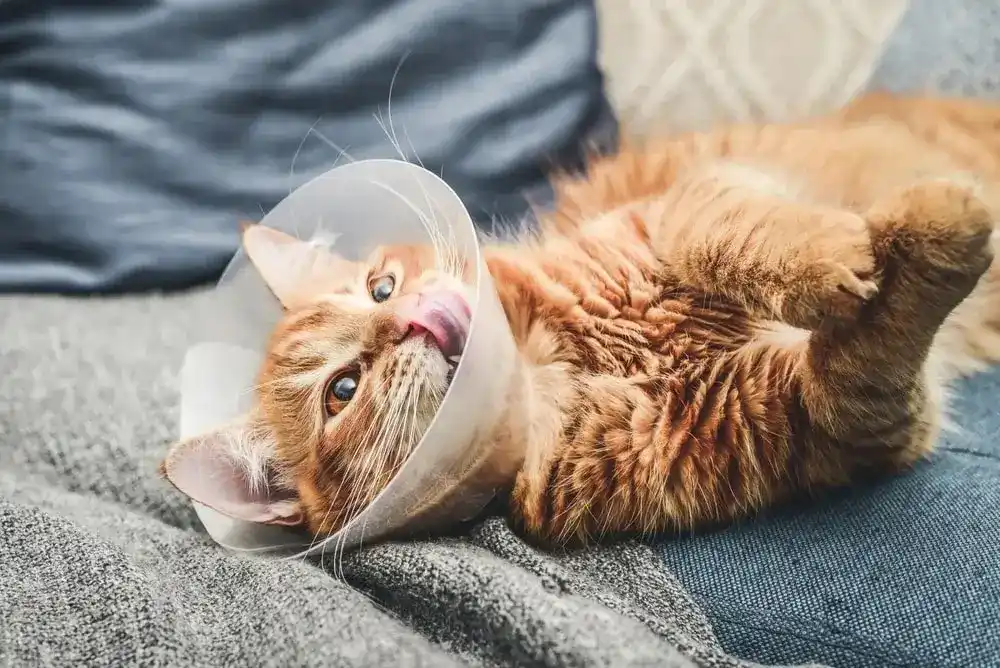PET HEALTH
If your cat is experiencing chronic urinary blockages, your vet may offer surgery as a solution. Perineal urethrostomy (PU) surgery is a standard procedure performed on male cats with urinary obstructions.1
PU surgery for cats can cost several thousand dollars, so it’s important to know when it’s necessary. Let’s dive into what PU surgery is, when it’s recommended, what to expect from the procedure, and how cat insurance can help you cover the vet bill.
Urinary Blockages May Hurt Your Cat and Your Wallet
What Is a Perineal Urethrostomy (PU)?
Feline PU surgery removes the narrowest part of the cat’s urethra, which is the tube that transports urine from the bladder. The goal of this surgery is to create a new opening to shorten the urethra. After the surgery, urine obstructions are less likely to occur, and if they do occur, they can pass more easily.1
Experts don’t fully understand why house cats develop urethral obstructions, though some believe infection and diet play a role.2 Male cats are more likely than female cats to experience chronic issues because of their anatomy, since a male cat’s urethra is slightly longer and narrows at the exit.1 Regardless of how these issues develop, they can cause blockages — like kidney stones or mucus — that get stuck in the urethra.2 If left untreated, urinary obstructions can be life-threatening.1
When Is PU Surgery Recommended for Cats?
Vets usually consider PU surgery for male cats with urinary obstructions only when other treatments have failed. Before going the surgical route, vets may treat urinary obstructions by using a catheter, which is inserted through the urethra and into the bladder. Then, a solution is used to flush the stones or mucus causing the obstruction. Afterward, your vet may prescribe antibiotics and pain medications, and they will likely recommend diet changes for your cat.2,3
However, a vet will only take this route a limited number of times before they offer surgery. PU surgery can provide your cat with long-term relief from symptoms of urinary tract diseases, like:2
- Increased urination
- Straining when urinating
- Blood in the urine
- Painful urination
- Urinating outside of the litter box
- Large, painful bladder
An obstruction can resolve within a week, but many cats have multiple episodes within 6 months to 1 year. In severe cases, cats may cry, become restless, or retreat from normal life. A complete obstruction can lead to death in 3 – 6 days.2
PU Surgery for Cats: Costs
The cost of PU surgery generally ranges from $1,500 to $3,000. However, in emergencies or if there are complications, the total cost could reach $5,000 or more.3
There may be additional costs, such as:3
- Diagnostics
- Physical exams
- Prescription medications
- Speciality food
- Hospitalization
- Follow-up visits
- Elizabethan collar (e-collar)
Your final bill can also depend on the severity of the obstruction, where you live, and your chosen vet.4 Pet parents should work with their vet for a complete quote to prepare accordingly.
Are there alternatives to PU surgery for cats?
As mentioned earlier, the vet can sometimes flush obstructions out from a cat’s urethra with a catheter, but that can only be done so many times before the cat will need PU surgery.
The best way to prevent your cat from needing PU surgery is by taking measures to prevent urinary obstructions. Here are a few things you can do:5
- Make sure your cat has fresh, running water and quality wet food.
- Enrich your cat’s environment with plenty of scratching posts.
- Play with your cat more often to increase their activity levels.
- Address any potential litter box issues (e.g., type of litter).
- Keep up with regular wellness visits.
Keep in mind that cats who develop urinary obstructions may have repeat episodes, leading to more money spent on vet visits and medications. PU surgery could be a way to help give cats long-term relief.1
What Should I Expect From Cat PU Surgery?
First, your cat may have a pre-surgery exam and blood work. This can help the team determine your kitty’s health status and which anesthesia they need. They may also offer intravenous (IV) fluids to correct any dehydration and electrolyte imbalances caused by the obstruction. This can help decrease the likelihood of post-surgery complications.1
During surgery, your cat may be placed under general anesthesia. Then, their stomach may be shaved to prepare the surgical site. After the area is prepped, the vet or surgeon will create a new urinary opening for your cat by removing the penis and suturing the larger part of the urethra to the skin.1
PU surgery takes about 1 – 2 hours to complete, and your cat will likely stay in the hospital for a day or two for observation. Also during this time, the vet may place a urethral catheter, monitor your cat’s urination, check on the incision site, and administer any IV fluids and pain medications.4
What’s cat PU surgery recovery like?
Cats must wear an Elizabethan collar or bodysuit for at least 2 weeks postop to prevent licking and biting at the surgical site.4 Your vet will recommend activity restrictions for your cat, such as keeping them in a small, confined area where you can watch them closely.1 If the vet used non-absorbable sutures, you will need to bring your cat back to the vet between 10 – 14 days postop to remove them.2
You should expect your kitty to have bloody urine and occasional accidents outside the litter box for up to 5 days after the operation. Keep an eye out for signs of infection, such as redness, swelling, and pain.4
Is my cat at risk for complications after PU surgery?
Your cat is unlikely to develop serious complications after surgery, but postop complications that require a trip to the vet can include:4
- Straining to urinate with no urine passed in more than 6 hours
- Vocalizing while straining to urinate
- Severe lethargy
- Vomiting
If your cat experiences diarrhea or constipation, you should contact your vet to discuss your options, though both can be a side effect of the anesthesia. It’s also important to note that about 25% of cats develop a bacterial urinary tract infection (UTI) within the first year after PU surgery.2
It’s possible for your cat to form obstructions too large to pass through the new urethrostomy opening, but most cats don’t develop large obstructions after PU surgery. Many won’t have any obstructions at all. As a result, the prognosis after surgery is typically good.1
Pet Insurance Can Help You Cover Perineal Urethrostomy Costs
PU surgery for cats can reduce the amount of pain and discomfort in your pet’s life, but it can be expensive. That’s where pet insurance can help. Take Shadow, for instance. This 7-year-old domestic short-hair cat was hospitalized for a urinary obstruction and had surgery to prevent future blockages. The total vet bill was over $7,000, but with cat insurance, Shadow’s pet parents got almost $6,200 back in their pocket.6
MetLife Pet Insurance can help pet parents pay for those expensive treatments like perineal urethrostomy surgery. Start by getting a free quote to insure your cat today.
Ready to Insure Your Pet? Start Your Free Quote
855-270-7387


